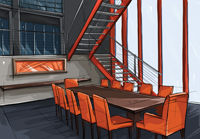The Creative Spirit
 Some people can be creative anywhere while others claim they are not creative at all. Many experts feel that anyone can be creative given the right encouragement and conditions. While people may debate “nature versus nurture”, the right environment can help stimulate creative thought and collaboration that leads to breakthrough innovations. There are many studies documenting the impact of environmental factors on health and well-being and we are increasingly mindful of the role environment plays in creativity and productivity. People who are relaxed, comfortable, and positively stimulated are known to be more creative and innovative.
Some people can be creative anywhere while others claim they are not creative at all. Many experts feel that anyone can be creative given the right encouragement and conditions. While people may debate “nature versus nurture”, the right environment can help stimulate creative thought and collaboration that leads to breakthrough innovations. There are many studies documenting the impact of environmental factors on health and well-being and we are increasingly mindful of the role environment plays in creativity and productivity. People who are relaxed, comfortable, and positively stimulated are known to be more creative and innovative.Since environments have a significant impact on productivity, morale and collaboration, the right mix of space, surroundings, stimuli and aesthetics can enable creativity in many ways. Environments that are most conducive to creativity can be created with focus on:
 Comfort: People need to be physically and psychologically comfortable to allow their minds to relax and stretch for creative thinking. Comfortable seating, space to move around, temperature and other factors all contribute to a creative environment. Many advocate bean bags and pillows, and other types of seating to help people relax. It is vital that participants have the opportunity to choose what works best for them.
Comfort: People need to be physically and psychologically comfortable to allow their minds to relax and stretch for creative thinking. Comfortable seating, space to move around, temperature and other factors all contribute to a creative environment. Many advocate bean bags and pillows, and other types of seating to help people relax. It is vital that participants have the opportunity to choose what works best for them.Space: There should be large open areas as well as smaller, more intimate spaces for individuals or small groups. The spaces should be flexible so individuals or groups can adjust in ways most effective and stimulating. The spatial arrangements should facilitate collaboration and interplay between members and be sure all can participate fully.
Color: Colorful spaces can make people feel more childlike, playful and adventurous, which is conducive to new ways of thinking. Colors create visual interest and can also help fight fatigue.
Lighting: There are many studies that indicate how light affects people’s moods and states of mind. Office workers report being happier and more productive when exposed to natural light, and there is evidence to connect exposure to daylight to a person’s perceived feeling of creativity. New technology allows us to use lighting to its best advantage to stimulate creativity. The new Philips Hue light system, for example, allows users to customize “light recipes” for specific needs — to relax, concentrate, energize and read.
Stimulus: Everything we see and experience can be stimulus to develop new insights and innovations. Art, products, games, music and sounds, aromas and textures can all be used to help stretch the way people think. Including a variety of these helps accommodate different personalities and thinking styles, ensuring auditory, visual, tactile and kinesthetic thinkers can fully engage.
Remember that creative environmental factors should not be limited to offices and meeting rooms. New ideas will strike during down time or impromptu conversations so decorating elevators, bathrooms, break rooms and social spaces with colors, designs and other elements can heighten the senses.
Often a more intense immersive environment is used for specific, targeted creative sessions aimed at a particular problem, market or segment. In those instances it is very effective to surround participants with relevant products, pictures, objects, smells, and other sensory input to stimulate creative thinking and ideas. Many times it is helpful to have such sessions in alternative locations to remove distractions from the office and allow the team to totally immerse in the subject matter. Immersing in nature can be a particularly rich experience. Comfort, safety and practicality should guide your environment selection.
